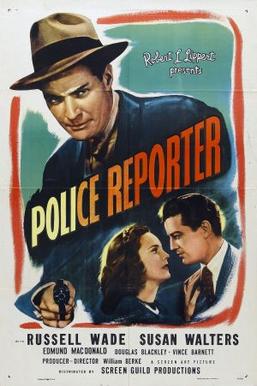Out In The 1940s Film Noir Night
– With Shoot To Kill In Mind
From The Pen Of Frank Jackman
You remember George Morse, the old time reporter, don’t you? Well if you
don’t he wasn’t just any guy around, any old
newsie, any old has been
or never was, but the old police beat reporter for the Bay View Gazette. So maybe you remember him, maybe not, but they use old
George these days, at least out here in California from what I can see, as the
standard for terse and concise reporting in the journalism schools, mostly night
schools in some old building down town that has seen better days but is just right
for quick turnaround courses in the whys and wherefores of journalism, now sprouting up like wildfire to snag guys back from
World War II with GI Bill dough into taking up the profession.
Funny though that George had barely finished high school and for that matter the
same with me, see I took over his beat
when he passed on ,so I don’t know what guys would do all day or
night day in class
except harp on each other’s florid prose. But that is a gripe for another time
because I have bigger fish to fry. See
this is about something George once told me, told me when I was just a cub
night police beat reporter, when we were downing a few after work at Lizzy’s Lounge
across from the Bay View police headquarters when I mentioned that the local crime scene seemed of
dull and pedestrian. He told me, told me in all seriousness that crime, and by
this he meant serious crime, not the nickel and dime stuff that small grifters
and midnight sifters embark upon and that I was reporting on but, you know
blackmail, extortion, influence-peddling, being in the hip pocket of
the mob, stuff like that is too serious to be left to amateurs, amateurs and those aforementioned grafters who give
crime a bad name.
Take the Crane case, the case of
a District Attorney, well, when he started out, an Assistant D.A., who turned
his knowledge of that George –etched fact to run one of the most wide open towns on the
coast here in Bay View, and made himself and his a pretty penny in the process and for a long while, a real long while, he was in the clover, him and Maxie Allen’s gang. And
here is where George’s wisdom came into play. See the line between the “good
guys” and the “bad guys” once you get out of the neighborhoods, once you get
away from the penny-ante jack-rolling, gas station armed robberies, the
department store clips, hell, a guy taking some kid’s milk money gets pretty blurry,
real blurry at times. Here in Bay View the old time D.A., Warner Baxter, had John
“Dixie” Logan, yes, that Dixie Logan who ran everything around here at one time
in his hip pocket and was making his own pretty penny off of that fact. And it
made sense, since the D.A. and his underlings are poorly paid public servants
and therefore need the extra dough to keep up with expenses. So maybe you would
find an oddball
Assistant D.A. who might be on the level, maybe a guy who went to the law
school over at Jacinto State, nights, while teaching high
school days, and maybe
wasn’t that bright a bulb and so being an Assistant D. A. was like dying and going to heaven but that wasn’t the
normal case not by a long shot. Everybody in the Costa County D.A.’s office
(and maybe everywhere) had somebody in his hip pocket just like Larry Crane had
Maxie Allen in his.
I’ll give you the most famous
case from up in Frisco so you know that if it goes on in a wide open town like Frisco then
everybody else is playing that same tune. A certain Assistant D.A. up there , I forget his name, had the infamous Pinky Foley in his
hip pocket, had him running while in the streets doing whatever he wanted in
the way of crime. See that Assistant D.A. was bucking for D.A. and his idea was to
corral Pinky in and impress the voters. And they
were impressed, elected him and Pinky went wild after that. So it wasn’t always about skimming the dough off the
top from minute one although that guy must have had some smarts, some
discipline, because he
was willing to wait until he became D.A to grab his share of the loot. Nice, right?
For those who don’t know the
Crane case, or were too young to see the beauty of the set-up here is the “skinny”
and I ought to know because I covered every day of the thing, and made my own pile
in the process once I got hipped to what that old con artist George told me.
See my graft is to get exclusive interviews with every big time crook, every
big time bad act, and I was in Crane’s hip pocket. My contract called
for big bonuses for big stories. And this one was big.
It all started with a frame-up, a
legal frame-up all done up in ribbons and bows by then Assistant D.A. Lawrence
Crane (he insisted everybody call him Larry just to show everybody what a
regular guys he was, not like those other
Harvard/Mayfair swells
for whence he came. I used to drive him crazy by always printing him up as
Lawrence even when I was in his hip pocket but see he needed me to be his flak
and so he let it ride). Yah, a be-bop
royal frame-up, complete with perjured witnesses and everything, of
one Dixie Logan. They wound up sending him up for a nickel, enough time to make him a very faded memory even among his trusted
lieutenants. Yes, that Dixie Logan, the guy who had his hand in everything that
went on in Bay View. Numbers, drugs, liquor, women, everything. See also
Lawrence Crane had a big, big appetite to be the next D.A. and so the frame-up
of Dixie Logan was calculated to aid in that plan. Warner Baxter was in Dixie’s
hip pocket (and I was then in Baxter’s hip pocket doing very well with his
tidbits thank you) and so to even the
playing field Crane let Maxie Allen and his gang go wild but he needed to clear
Dixie away, away for good. And so the frame-up. But here is where things got
dicey, and would get dicier for Brother Crane. Dixie had retired from his
gangland habits some time before the squeeze play went down and so he was in no
mood to do a nickel for stuff he didn’t do. More importantly Ellen Kelly,
Dixie’s main squeeze (his wife okay) didn’t like it one bit since she was
reason number one, and the only reason that Dixie quit the rackets.
Ellen Kelly, a classmate of mine
at Saint Rose’s Parochial School (the one over near Bay View Beach not Saint Rose of Padua over near Highway 101)
back in the day in elementary school had a crush on John Logan (she never ever
called him Dixie and he stood the gaff on it with her) from about that time
even though he was a few years older, and even then deep into the cheapjack
rackets, mainly stealing cars. Now Ellen, if you can believe this, was then
nothing but a novena-praying, Stations of the Cross adoring religious nut, at least in my book. But to
her John could do no wrong and so when she came of age, came of beauty age and Dixie began to notice her
that was that. Eventually they got married and it was not until then that Ellen
was aware how deeply Dixie was into the rackets. But she kept pounding on him
to quit, maybe get a real job, or something. Jesus. But eventually Dixie
retired and that was when Crane sprung his trap.
And that was when Ellen (and
Dixie although he was not the brains behind this, Ellen and importantly, Baxter
were) sprung her Crane trap. See Crane besides considering himself a regular
guy also saw himself as a lover boy, a big time lover boy based on his prowess
with the female side of the Mayfair swell crowd (although those Mayfair
gold-diggers only thought of dollar signs and good connections) and so Ellen
went undercover for her John as Crane’s secretary. Apparently Crane had not
done his homework to figure out who Dixie was seeing, was connected with
romantically, and Ellen slipped through the net. Slipped through
easily for once she put on the faux
come hither look on Larry could hardly contain himself. Naturally after about
six dates (and who knows how many romps in the hay, although lets’ keep that
figure from Dixie since he might take umbrage at Ellen’s too eager role as
seductress for all I know) Larry proposed marriage, and Ellen accepted,
accepted with both hands. And so they ran up the coast to Eureka and were
married. End of story.
Oh you think that can’t
be the end of the story?
Well, okay, not quite but actually if you looked at it from one perspective you
would know it was over. Obviously Ellen, already married, was a bigamist. Was a bigamist that is if she and
Larry had actually been married. The whole Eureka caper was a hoax. The JP that married then was not a
JP but one of Dixie’s old cronies brought in for the part. So Larry was
squeezed either way in his desire to be D.A.
Either he took the fallout from the marrying a bigamist angle or from
being stupid enough to fall for the fake marriage. Not the kind of things that would endear the
citizenry, not even a dumb cluck citizenry. And so Larry faded from view,
Warner Baxter kept his job as D.A. and kept his percentage of the take from the newly-released Dixie.
Oh yah, as it turned out old
Dixie was getting antsy in "retirement” and so as a come-back wiped out Maxie
Allen and his gang from the face of Bay View as a public service. And Larry did
not so much fade out as find himself along a side road, face down, with two slugs in his head for his mistakes. The D.A.
office called that one done by parties unknown and quickly closed the case. As
for Ellen one night Dixie pistol-whipped her badly for taking just a little too
much pleasure in her work- out with Larry once he found out the details that got
from a guy he had following the couple. Last anyone heard she was working in
some whorehouse up over on the Barbary Coast. Me, me I’m writing up big
time stories about how one Dixie Logan helped clean up crime in Bay View. See,
I told you that crime was too important to be left to amateurs.










